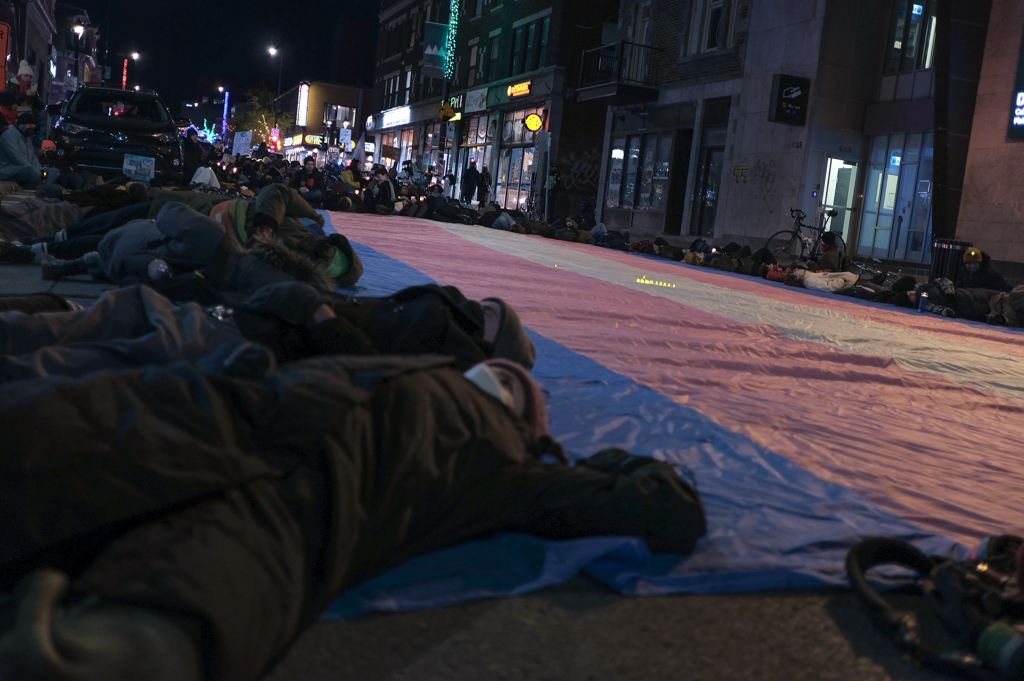Montreal’s first trans remembrance march honours and celebrates the lives taken away too soon.
The Transgender Day of Remembrance (TDoR) on Nov. 20 saw the Montreal community gather for its first trans remembrance march to honour the trans lives that have been lost to hate. Hundreds of supporters gathered at the Sir-George-Étienne Cartier monument where candles lit up the night sky and a large trans flag was draped in front of the monument.
The commemoration started with a speech from Celeste Trianon, a transfeminine jurist and one of the organizers of the march, and other queer group members. Trianon commemorated all the trans people who have died in recent years. After a moment of silence, the group gathered on Park Avenue for a quiet march towards Mont-Royal street.
Trianon felt that a traditional vigil was the best way to commemorate these lives. She did not want to steer away from the “remembering” part of a vigil, and wanted to bring attention our society’s failure to protect the members of the trans community.
“Some people only define trans remembrance as remembering murders, but I want to go beyond that,” said Trianon. “There are trans people all around us and it’s important to mark how, in the vast majority of cases, trans people have ended up dying owing to vast failures, whether it be society’s failure to eradicate anti-trans hate, failures within mental health support systems and the schooling system.”
On Oct. 20, Saskatchewan’s conservative government passed Bill 137, or The Parental Bill of Rights, which uses a notwithstanding clause to prevent trans youth from changing their names or pronouns in schools. For the youth under the age of 16 who want to change their name or pronouns will need parental consent first. When Trianon found out about the bill’s passing, she was horrified.
This bill is one of the many recent examples targeting the trans community in the last few months. According to True Colors United, over 320 murders towards trans people have been confirmed globally in this year alone.
“These people will never get the respect that they deserve. Their death certificate will indicate the wrong name. They’ll be purposely misgendered by their parents,” said Trianon.
Fae Johnstone, president of Queer Momentum, accompanied Trianon to Ottawa to confront the Trudeau government about an action plan for trans equality and protection. As trans hate grows across the country, Johnstone believes that a commemoration like this is necessary for all 2SLGBTQIA+ people.
“It’s more important than ever that none of those names are forgotten and that we remember that the fight that our trans elders began decades ago,” said Johnstone. “It’s still unfinished, and that is what these marches and gatherings really are all about.”
In 1999, the TDoR came into existence following the brutal murder of Rita Hester, a trans woman of colour, in her home on Nov. 28., 1998. To this day, her murder remains unsolved.
Even though Hester never received the justice she deserved, her name and that of every trans life that is no longer here, will never be forgotten.
After the quiet march down Park Avenue and Mount-Royal street, the group stopped in front of Mount-Royal metro to lie down on the ground in honour of all trans people killed. They lay there in another moment of silence as Trianon addressed the group.
“Let us build a road in which trans people, especially trans women, and in particular trans women of colour, are allowed not only to survive, but to thrive” she spoke. “Let us dream of a better road for trans people everywhere and make sure these dreams come true. If there’s hope for the future, it’s our duty to make it happen, not just for the privileged ones among us, but all of us.”
Smoke bombs were ignited, releasing the colours of the trans flag: pink, blue, and white.
“For you Cici, for you Jasmine, and Victor. For you Jesse, for you Jacob. We shall continue to remember. For all of you who I have failed to name, but I know are there. For all, and for all of you who are barely hanging in there,” Trianon ended her speech.
